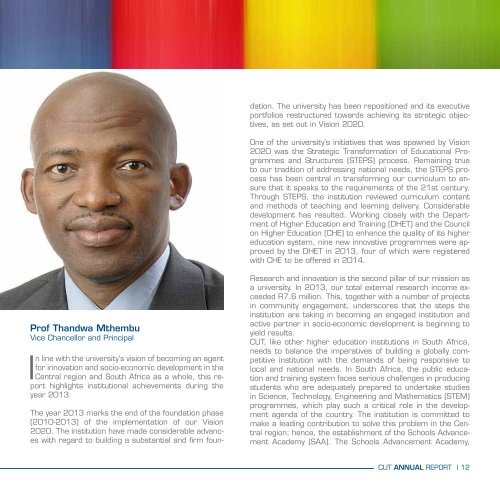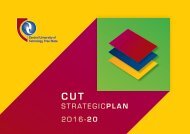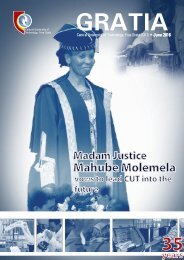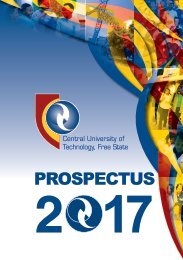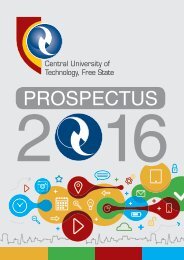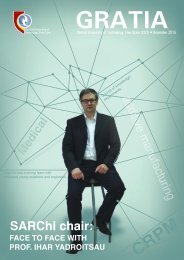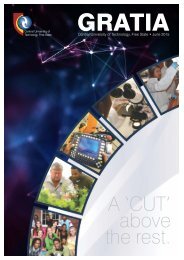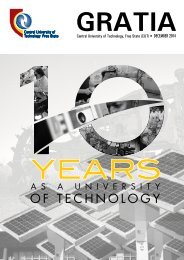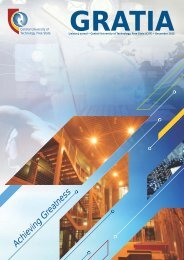CUT Annual Report 2013
The Annual Report is a premier publication that reports on institutional development and successes.
The Annual Report is a premier publication that reports on institutional development and successes.
You also want an ePaper? Increase the reach of your titles
YUMPU automatically turns print PDFs into web optimized ePapers that Google loves.
MANAGEMENT<br />
Message from the Vice-Chancellor and Principal<br />
Prof Thandwa Mthembu<br />
Vice Chancellor and Principal<br />
In line with the university’s vision of becoming an agent<br />
for innovation and socio-economic development in the<br />
Central region and South Africa as a whole, this report<br />
highlights institutional achievements during the<br />
year <strong>2013</strong>.<br />
The year <strong>2013</strong> marks the end of the foundation phase<br />
(2010-<strong>2013</strong>) of the implementation of our Vision<br />
2020. The institution have made considerable advances<br />
with regard to building a substantial and firm foundation.<br />
The university has been repositioned and its executive<br />
portfolios restructured towards achieving its strategic objectives,<br />
as set out in Vision 2020.<br />
One of the university’s initiatives that was spawned by Vision<br />
2020 was the Strategic Transformation of Educational Programmes<br />
and Structures (STEPS) process. Remaining true<br />
to our tradition of addressing national needs, the STEPS process<br />
has been central in transforming our curriculum to ensure<br />
that it speaks to the requirements of the 21st century.<br />
Through STEPS, the institution reviewed curriculum content<br />
and methods of teaching and learning delivery. Considerable<br />
development has resulted. Working closely with the Department<br />
of Higher Education and Training (DHET) and the Council<br />
on Higher Education (CHE) to enhance the quality of its higher<br />
education system, nine new innovative programmes were approved<br />
by the DHET in <strong>2013</strong>, four of which were registered<br />
with CHE to be offered in 2014.<br />
Research and innovation is the second pillar of our mission as<br />
a university. In <strong>2013</strong>, our total external research income exceeded<br />
R7.6 million. This, together with a number of projects<br />
in community engagement, underscores that the steps the<br />
institution are taking in becoming an engaged institution and<br />
active partner in socio-economic development is beginning to<br />
yield results.<br />
<strong>CUT</strong>, like other higher education institutions in South Africa,<br />
needs to balance the imperatives of building a globally competitive<br />
institution with the demands of being responsive to<br />
local and national needs. In South Africa, the public education<br />
and training system faces serious challenges in producing<br />
students who are adequately prepared to undertake studies<br />
in Science, Technology, Engineering and Mathematics (STEM)<br />
programmes, which play such a critical role in the development<br />
agenda of the country. The institution is committed to<br />
make a leading contribution to solve this problem in the Central<br />
region; hence, the establishment of the Schools Advancement<br />
Academy (SAA). The Schools Advancement Academy,<br />
which was officially launched in <strong>2013</strong>, provides support to<br />
schools in the Central region through its various projects,<br />
and, predominantly, the extra classes that are provided to<br />
school learners thorough the Saturday, Winter and Spring<br />
Schools. In addition, through our Educator Mentorship and<br />
Development Program (EMDP), the institution strive to<br />
improve the knowledge and teaching competencies of educators<br />
in Science, Technology, English and Mathematics.<br />
Beyond the Central region, the institution are exploring opportunities<br />
for international strategic partnerships that will continue<br />
to build upon in the next phase of the implementation of<br />
Vision 2020. In <strong>2013</strong>, our internationalisation strategy was<br />
launched to consolidate extensive international partnerships<br />
and networks and leverage resources to strengthen the institution’s<br />
capacity in its core responsibilities. Our internationalisation<br />
strategy has been operationalised through the establishment<br />
of the International Office, whose staff assumed<br />
duty at the beginning of 2014. In <strong>2013</strong>, 3.8% of our student<br />
complement consisted of international students. In order to<br />
ensure a diverse student body that will enhance the learning<br />
experience of all our students, our objective is that, by 2020,<br />
at least 10% of our students would be international students,<br />
recruited from the rest of the African continent and beyond.<br />
Whilst this report highlights the progress the institution has<br />
made in realising the goals of Vision 2020, it is important<br />
to take into account the factors that play an important role<br />
in the success of the institution. Financial management continued<br />
to improve in the year <strong>2013</strong>, wherein our preliminary<br />
financial results were positive. Expenditure remained within<br />
the parameters as set by Council, and financial reserves<br />
were consolidated. Debt collecting has improved significantly.<br />
At the end of September <strong>2013</strong>, the outstanding debtors’<br />
book was 42.43%, compared to September 2012, when it<br />
was 49.80% of the debit charged. In the years ahead, the<br />
challenge will be related to the containment of the salary<br />
budget; the prudent investment in the academic project, especially<br />
in human resources capacity, equipment and infrastructure;<br />
as well as to managing expenditure. Furthermore,<br />
a Resources Allocation Model (RAM) has been developed<br />
with a view of ensuring more efficient allocation of resources<br />
and also of strengthening the linkage between planning and<br />
budgeting. The model was tested in <strong>2013</strong>, has been partially<br />
implemented in 2014 and will be in full operation in 2015.<br />
Our staff and students demand better resources and a more<br />
comprehensive and decent infrastructure as required of a<br />
modern institution of higher learning. The provision of worldclass<br />
infrastructure remains very high on our agenda. Over<br />
the past three years, over R250 million has been invested<br />
in various key facilities for our students. The university is<br />
grateful to the DHET and Council for their contributions towards<br />
this investment. The institution now have six state-ofthe-art<br />
buildings as part of our academic infrastructure, two<br />
of which are at the Welkom campus and for which we spent<br />
a total of R60 million.<br />
Further development is continuing on both campuses to provide<br />
for improved academic infrastructure and residential<br />
buildings, following an additional R314 million investment by<br />
the DHET and our Council for the period 2012-2015. For all<br />
the success, I am indebted to all stakeholders for the strong<br />
support and the respectable growth we have experienced.<br />
My heartfelt gratitude goes to the DHET for its continued commitment<br />
to supporting <strong>CUT</strong>, and I look forward to an exciting period in the<br />
institution’s transformation.<br />
<strong>CUT</strong> ANNUAL REPORT | 12<br />
13 | <strong>CUT</strong> ANNUAL REPORT


